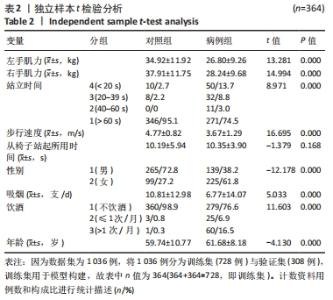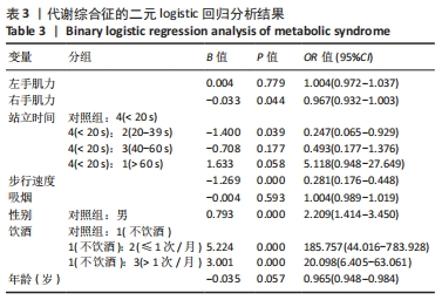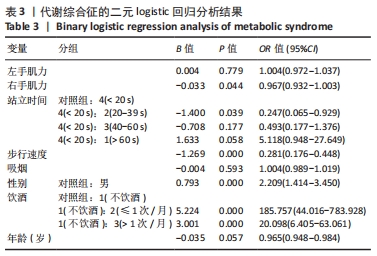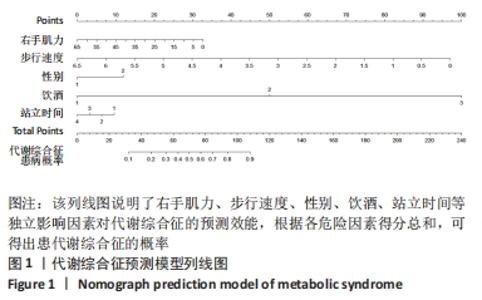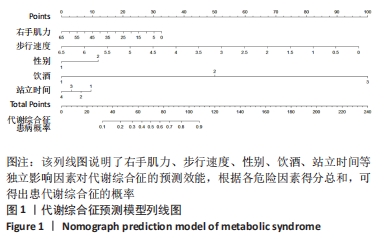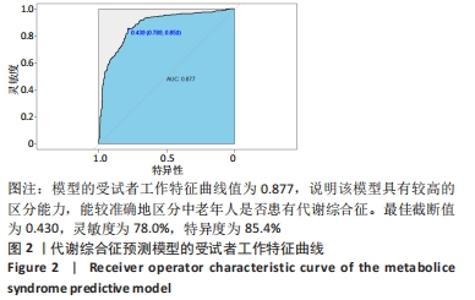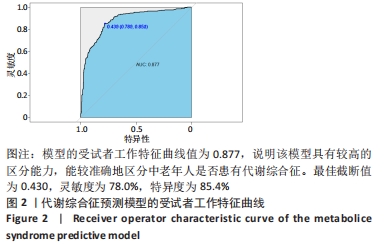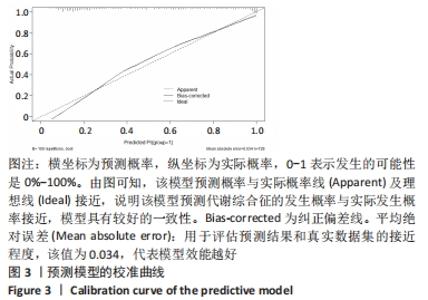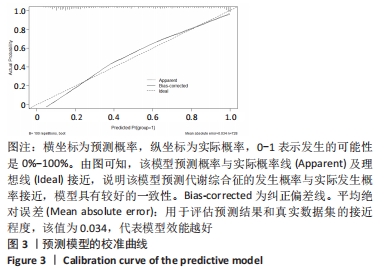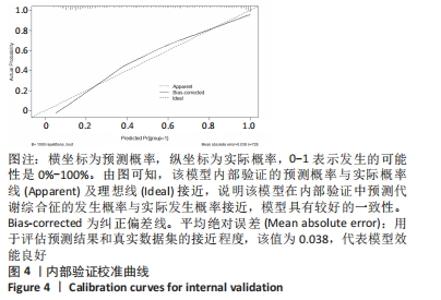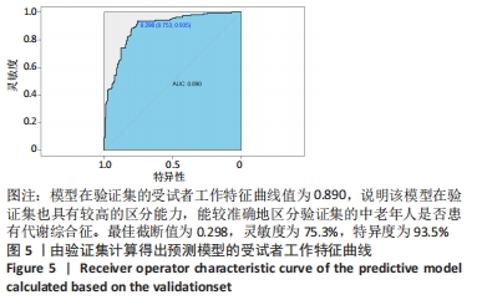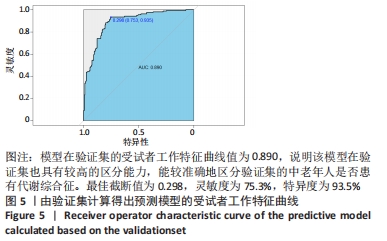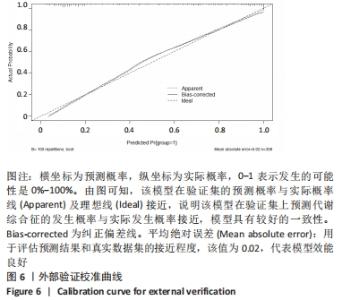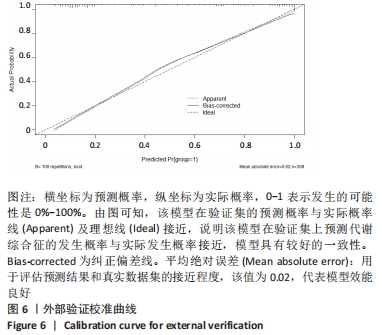Chinese Journal of Tissue Engineering Research ›› 2023, Vol. 27 ›› Issue (5): 657-662.doi: 10.12307/2022.1005
Risk factor analysis of metabolic syndrome and construction of a nomogram prediction model in middle-aged and elderly people
Shen Lianwei, Zhu Hongliu, Wang Wei
- First Affiliated Hospital of Jinzhou Medical University, Jinzhou 121000, Liaoning Province, China
-
Received:2022-01-07Accepted:2022-02-16Online:2023-02-18Published:2022-07-23 -
Contact:Wang Wei, Master, Associate chief physician, First Affiliated Hospital of Jinzhou Medical University, Jinzhou 121000, Liaoning Province, China -
About author:Shen Lianwei, Master candidate, First Affiliated Hospital of Jinzhou Medical University, Jinzhou 121000, Liaoning Province, China
CLC Number:
Cite this article
Shen Lianwei, Zhu Hongliu, Wang Wei. Risk factor analysis of metabolic syndrome and construction of a nomogram prediction model in middle-aged and elderly people[J]. Chinese Journal of Tissue Engineering Research, 2023, 27(5): 657-662.
share this article
Add to citation manager EndNote|Reference Manager|ProCite|BibTeX|RefWorks
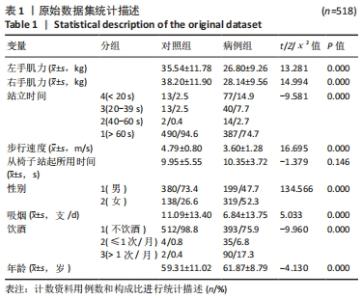
2.1 中老年人代谢综合征检出状况 共纳入7 383名体检者,按照中国内分泌协会关于代谢综合征的诊断标准,分为对照组(6 865例)和病例组(518例),检出率为7%。 2.2 原始数据集统计描述 研究不可避免存在混杂因素,会夸大或掩饰纳入变量与研究结局的真实关联性。倾向性评分法是解决此问题统计方法之一,在医学各领域的应用不断得到证实,因而在此次研究的原始数据集采用了此方法[27]。原始数据集中共有1 036例,其中代谢综合征患者518例,非代谢综合征患者518例,病例组与对照组在左手肌力、右手肌力、站立时间、步行速度、性别、年龄、吸烟、饮酒上分布不同,差异均有显著性学意义(P < 0.05),见表1。"
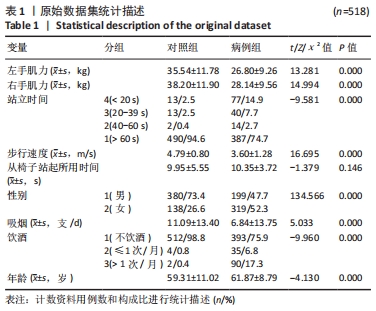
| [1] 中华医学会糖尿病学分会代谢综合征研究协作组.中华医学会糖尿病学分会关于代谢综合征的建议[J].中国糖尿病杂志,2004,12(3): 156-161. [2] 曾洪利,黄鲁,王万淑.内脏脂肪面积与代谢综合征的相关性分析[J].中国疗养医学,2021,30(12):1255-1258. [3] XU Y, WANG L, HE J, et al. Prevalence and Control of Diabetes in Chinese Adults. JAMA. 2013;310(9):948-959. [4] GRUNDY SM. Metabolic syndrome pandemic. Arterioscler Thromb Vasc Biol. 2008;28(4):629-636. [5] 刘鲁豫,刘爱霞,王露露,等.老年代谢综合征流行病学调查及预防措施[J].公共卫生与预防医学,2021,32(3):107-110. [6] 杨剑,许雷,王绍坡,等. 老年代谢综合征患者中医体质辨识[J]. 中国老年学杂志,2021,41(13):2715-2718. [7] 孙广山.代谢综合征[J].医学理论与实践,2009,22(1):1-3. [8] 马丽,李红.粪菌移植在代谢综合征治疗中的研究现况[J].国际内分泌代谢杂志,2021,41(4):300-303. [9] MCCRACKEN E, MONAGHAN M, SREENIVASAN S. Pathophysiology of the metabolic syndrome. Clin Dermatol. 2018;36(1):14-20. [10] ECKEL RH, GRUNDY SM, ZIMMET PZ. The metabolic syndrome. Lancet. 2005;365(9468):1415-1428. [11] 庞利娟,白荣莉,湛斌,等.基于数据挖掘技术对代谢综合征治疗方法的分析[J].重庆医学,2019,48(7):1168-1171. [12] SHERLING DH, PERUMAREDDI P, HENNEKENS CH. Metabolic Syndrome. J Cardiovasc Pharmacol Ther. 2017;22(4):365-367. [13] SAKLAYEN MG. The Global Epidemic of the Metabolic Syndrome. Curr Hypertens Rep. 2018;20(2):12. [14] 杨蓉,王鹏,屈文静.脓毒症患者继发持续性炎症-免疫抑制-分解代谢综合征的影响因素及预测模型构建[J]. 海南医学,2021, 32(17):2182-2185. [15] 王传海,王新江,田慧,等.老年人腹部脂肪(CT测量)分布与体质指数及代谢综合征的关系[J]. 中华医学杂志,2014,94(12):908-912. [16] 闫小光,王宝,张亚强,等.老年代谢综合征影响因素及其中医证候特征的临床分析[J]. 世界中西医结合杂志,2021,16(5):957-960. [17] ZHAO Y, STRAUSS J, YANG G, et al. China Health and Retirement Longitudinal Study, 2011-2012 National Baseline Users’ Guide, National School of Development, Peking University. 2013. [18] 梁雪. 痰湿体质人群易发代谢综合征的危险因素筛选和诊断模型构建研究[D].北京:北京中医药大学,2017. [19] 张雪,谭明英,陈华英.全程管理模式对门诊疑似乳腺癌患者诊疗依从性的影响研究[J]. 成都医学院学报,2021,16(2):157-160. [20] 李潇骁,郝聪,贺新宁,等.中国中老年人群髋部骨折疾病负担及其影响因素分析[J]. 中华骨科杂志,2020,40(21):1461-1468. [21] 涂永前,金旻禛,张晨,等.城镇低龄老年人力资源开发的影响因素及供需匹配研究——基于北京、天津和济南的调研[J]. 创新, 2021(1):9-23. [22] 蔡伦. 基于G--formula模型的中国中老年人跌倒的模拟干预和中介效应分析[D]. 厦门:厦门大学,2019. [23] JUTBERGER H, LORENTZON M, BARRETT CONNOR E, et al. Smoking predicts incident fractures in elderly men: Mr OS Sweden. J Bone Miner Res. 2010;25(5):1010-1016. [24] 刘静,赵冬,刘军,等. 代谢综合征与自由脂肪酸的关系[J]. 中华心血管病杂志,2005,33(7):653-657. [25] 陈晓梅. 105名健康体检者颈动脉病变及相关危险因素探讨[J]. 实用医学影像杂志,2013,14(4):298-299. [26] MAARTEN VS,KAREL GM,DE AH, et al. Sample size for binary logistic prediction models: Beyond events per variable criteria. Statistical Methods Med Res. 2018:096228021878472. [27] 张丽伟,江淑芳,狄佳,等. 基于倾向性评分匹配的髋关节术后肺炎危险因素[J]. 中国感染控制杂志,2021,20(7):607-613. [28] 范建高, 朱军. 饮酒与代谢综合征[J]. 国际内分泌代谢杂志,2004, 24(6):370-372. [29] 李亚茹,赵丽云,于冬梅,等.中国成人饮酒与代谢综合征的关系[J].卫生研究,2019,48(4):531-536. [30] 冯磊,年士艳,山德生,等. 不同性别代谢综合征患病情况分析[J]. 实用医学杂志,2007,23(5):664-665. [31] 徐旭,刘耘,梁国威.代谢综合征患病率随性别和年龄的变化趋势[J].医学研究杂志,2011,40(5):88-91. [32] 刘颖,弓岩岩.代谢综合征危险因素与发病关系的前瞻性分析[J].解放军预防医学杂志,2020,38(7):53-56. [33] 任重宇,杨光,白翠瑾,等.代谢综合征差异下区域老年人运动能力的比较[J].中国老年学杂志,2016,36(4):896-898. [34] KIM TN, PARK MS, YANG SJ, et al. Prevalence and Determinant Factors of Sarcopenia in Patients With Type 2 Diabetes: The Korean Sarcopenic Obesity Study (KSOS). Diabetes Care. 2010;33(7):1497-1499. [35] EVANS WJ, PAOLISSO G, AB BA TECOLA AM, et al. Frailty and muscle metabolism dysregulation in the elderly. Biogerontology. 2010;11(5): 527-536. [36] 齐淑静,齐瑞霞,张午临,等.肌肉减少症与代谢综合征关系的研究进展[J].肿瘤代谢与营养电子杂志,2018,5(3):324-327. [37] MOMMA H, NIU K, KOBAYASHI Y, et al. Skin advanced glycation end product accumulation and muscle strength among adult men. Eur J Appl Physiol. 2011;111(7):1545-1552. [38] SEMBA RD, BANDINELLI S, KAI S, et al. Relationship of an advanced glycation end product,plasma carboxymethyl-lysine,with slow walking speed in older adults: the InCHIANTI study. Arbeitsphysiologie. 2010; 108(1):191-195. [39] IASONOS A, SCHRAG D, RAJ GV, et al. How to build and interpret a nomogram for cancer prognosis. J Clin Oncol. 2008;26(8):1364-1370. [40] 张君玲,覃健,许霞,等.广西长寿地区老年人代谢综合征的患病情况分析及预测模型建立[J].老年医学研究,2021,2(4):18-22. [41] 杨兴华,陶秋山,孙凤,等.台湾地区35-74岁健康体检人群代谢综合征发病风险预测模型的建立[J].中华流行病学杂志,2013,34(9): 874-878. [42] 孙苑潆,杨亚超,曲明苓,等.健康管理人群代谢综合征发病风险预测模型[J].山东大学学报:医学版,2017,55(6):87-92. [43] 龙玉其.医疗服务体系的满意度评价——基于2557个城乡不同收入家庭的调查[J].社会保障研究,2011(1):92-96. [44] 刘增超,袁建芬,胡磊.无锡市新区社区卫生医疗服务满意度综合评价[J].公共卫生与预防医学,2015,26(4):58-60. [45] 夏天,郝林,蒋博,等.预测输尿管结石ESWL清石率列线图的建立与内部验证[J].徐州医科大学学报,2021,41(7):515-521. [46] 谷鸿秋,王俊峰,章仲恒,等.临床预测模型:模型的建立[J].中国循证心血管医学杂志,2019,11(1):14-16+23. [47] 谷鸿秋,周支瑞,章仲恒,等.临床预测模型:基本概念、应用场景及研究思路[J].中国循证心血管医学杂志,2018,10(12):1454-1456+1462. [48] 文玲子,王俊峰,谷鸿秋. 临床预测模型:新预测因子的预测增量值[J]. 中国循证心血管医学杂志,2020,12(6):655-659. |
| [1] | Liu Guangluan, Guo Zonglei, Ge Jin, Huang Dong, Wang Yehua. Anatomic risk factors for medial meniscus posterior root tears combined with anterior cruciate ligament injuries [J]. Chinese Journal of Tissue Engineering Research, 2023, 27(5): 663-668. |
| [2] | Wang Kaiyu, Hu Peng, Wei Zairong, Huang Guangtao, Zhou Jian, He Guijia, Nie Kaiyu. Use of expanders and implants in breast reconstruction complicated with infection [J]. Chinese Journal of Tissue Engineering Research, 2023, 27(3): 461-469. |
| [3] | Zhang Qian, Bian Minjie, He Qin, Huang Dongfeng. Predicting vascular mild cognitive impairment based on vascular risk factors: construction and application of a support vector machine model [J]. Chinese Journal of Tissue Engineering Research, 2023, 27(2): 287-292. |
| [4] | Wu Liang, Wang Qiang, Wang Wenbo, Xin Tianwen, Xi Kun, Tang Jincheng, Xu Jingzhi, Chen Liang, Gu Yong. Risk factors for traumatic central cord syndrome underlying with cervical spondylotic myelopathy [J]. Chinese Journal of Tissue Engineering Research, 2022, 26(9): 1388-1394. |
| [5] | He Shiping, Jia Dazhou, Li Xiaolei, Wang Qiang. Establishment of prediction model of blood transfusion after proximal femoral nail anti-rotation fixation of femoral intertrochanteric fracture in elderly adults [J]. Chinese Journal of Tissue Engineering Research, 2022, 26(6): 929-933. |
| [6] | Liu Yiyi, Qiu Junqiang, Yi Longyan, Zhou Cailiang. Effect of resistance training on interleukin-6 and C-reactive protein in middle-age and elderly people: a Meta-analysis [J]. Chinese Journal of Tissue Engineering Research, 2022, 26(5): 804-812. |
| [7] | Rong Yi, Yu Hao, Yang Junfeng, Wang Lan, Zhang Jiannan, Shao Yang. Risk factor analysis and prediction of deep venous thrombosis of lower extremity in elderly patients with hip fracture after operation [J]. Chinese Journal of Tissue Engineering Research, 2022, 26(33): 5357-5363. |
| [8] | Zhou Shicheng, Han Hongguang, Ji Fang, Xu Liying, Zhang Xiaohui, Sun Chang. Effect and histocompatibility of expended polytetrafluoroethylene in modified Blalock-Taussig shunt [J]. Chinese Journal of Tissue Engineering Research, 2022, 26(21): 3394-3400. |
| [9] | Liu Chen, Hu Chengzhe, Yin Xun, Yu Ziheng, Yang Jiandong. Risk factors of residual pain after percutaneous vertebral augmentation for osteoporotic thoracolumbar compression fractures [J]. Chinese Journal of Tissue Engineering Research, 2022, 26(18): 2900-2905. |
| [10] | Li Wenle, Wang Haosheng, Ning Lijun, Zhang Wenshi, Gao Sen, Sun Lijun, Hu Zhaohui. Analysis of the risk for bone cement leakage after percutaneous vertebroplasty in osteoporosis patients and model verification [J]. Chinese Journal of Tissue Engineering Research, 2022, 26(10): 1477-1482. |
| [11] | Zhang Yu, Tian Shaoqi, Zeng Guobo, Hu Chuan. Risk factors for myocardial infarction following primary total joint arthroplasty [J]. Chinese Journal of Tissue Engineering Research, 2021, 25(9): 1340-1345. |
| [12] | Wang Haiying, Lü Bing, Li Hui, Wang Shunyi. Posterior lumbar interbody fusion for degenerative lumbar spondylolisthesis: prediction of functional prognosis of patients based on spinopelvic parameters [J]. Chinese Journal of Tissue Engineering Research, 2021, 25(9): 1393-1397. |
| [13] | Zhang Chao, Lü Xin. Heterotopic ossification after acetabular fracture fixation: risk factors, prevention and treatment progress [J]. Chinese Journal of Tissue Engineering Research, 2021, 25(9): 1434-1439. |
| [14] | Chen Chaofeng, He Dadong, Liang Jincheng, He Zhijun. Predicting the possibility of blood transfusion after total knee arthroplasty based on machine learning algorithm [J]. Chinese Journal of Tissue Engineering Research, 2021, 25(36): 5792-5797. |
| [15] | Su Baotong, Wang Hanyu, Xu Yilang, Xie Yajuan, Cheng Zhian. Construction of a Nomogram prediction model for postoperative delirium after hip fracture in the elderly based on medical records from a hospital [J]. Chinese Journal of Tissue Engineering Research, 2021, 25(24): 3844-3849. |
| Viewed | ||||||
|
Full text |
|
|||||
|
Abstract |
|
|||||
